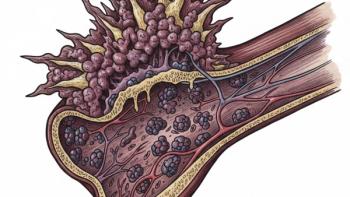
Melanoma by the Numbers
Key Takeaways
- The patient progresses from stage 2A melanoma to stage 4, with metastases in the breast and lung, facing significant emotional and physical challenges.
- Participation in an expanded access program for ipilimumab and nivolumab results in a complete response, but new aggressive tumors necessitate further treatment.
The facts and figures of what the trajectory of a melanoma diagnosis looks like.
It has been almost exactly six years since my stage 2A diagnosis. A mole. Right inner knee. Three centimeters deep. At the time, I was living 10,000 miles from home.
A PET scan one year later (which I only paid about $100 for) does not turn up any sign of cancer. I'm not that scared.
In 2013, a lymph node in my groin is suddenly the size of a golf ball. The stage 3 shitstorm commences: two surgical procedures and six weeks of radiation, five days per week, during which I am naked from the waist down with a team of four young, male doctors drawing lines on my thighs and speaking in a language I do not understand. Dehumanizing is the word that comes to mind.
What follows is my first bout with lymphedema. My right leg swells to twice it's normal size and stays that way for six months. People call me a hippie for playing gigs with my band barefoot. The truth is, shoes don't fit.
Exactly one year later, December 2014, there’s a pea-sized lump on my chest. Scans reveal further metastasis of two tumors - right breast and left lung. Stage 4.
The Internet tells me that there is a 15 percent chance that I would survive longer than two years. The average survival rate is between six and 12 months. Now I'm scared shitless.
I have two weeks to pack up eight years of my life, grade 150 final exams and figure out how to get my 80-pound yellow lab to JKF airport with me.
Just about three weeks after I land back in NY, I am at NYU Langone Medical Center and I learn that I will be one of less than 300 people in the country to be included in an EAP (expanded access program) for a groundbreaking new treatment.
I am given four infusions of
I then proceed to have two infusions per month of just Opdivo (for maintenance), over the course of nine months. During this time, my tumors disappear, and I maintain my status of NED (no evidence of disease).
I accumulate an arsenal of five or six OTC (over the counter) drugs that I must have on hand at all times. I average one to two mild to moderate side effects per treatment period. I am one of the lucky ones.
My thyroid gland craps out, and I begin a regimen of 125 mcg of Levothyroxine per day. My oncologist has had to adjust the dosage of my thyroid meds at least five times. I cannot eat for two hours before and one hour after taking these meds. It's a pain in the ass.
Final infusion day/ supposed one-year cancer-free day: bang. Four new tumors, which really turn out to be five tumors. They are large, aggressive and oozing. The next day, I must receive three pints of blood. We like to think they were donated by Oprah Winfrey, Superman and Lucy's friend, Harold.
I go on a new drug combination. Pills
I don't stay on these drugs long enough for nicknames. Within two weeks, my body goes haywire. I spend four days in the hospital with a fever of 103 every four to six hours.
I try the drug combo again, and 45 minutes after my first dose back, my body explodes and I feel like I'm laying in a nest of fire ants. Anaphylaxis. Luckily, Benadryl does the trick.
I spend some time on 120 mg of Prednisone. The average dose is 20 mg. Between the superman blood and the steroids, I'm on fire. I start producing a painting, like, every four hours ... and I'm not even a painter.
I start a new drug combination. For this event, I procure two EpiPens
Zelboraf begets the very special effect of extreme photosensitivity. I accumulate three floppy hats. I wear none of them. Instead, I opt for the simple black “dad cap” I purchased for $7 on Amazon. I alternate between looking like a vampy goth chick and someone who is hiding from the feds. All of my clothing is stained with SPF70.
Within three days on the meds, my hands are covered in first-degree burns. I add two sets of driving sleeves to my repertoire. My lymphedema rears its head in my leg, and I add a 25-30 mmHg compression stocking to my wardrobe. People stare. It's fun.
After three months, I have a set of scans done. Of the three tumors that remain, two have shrunken significantly and one has stayed the same size. The other two have disappeared.
I got those scan results 31 days ago. In approximately 60 days, I will be scanned again. Between now and then, I will likely I will spend no less than five sleepless nights wondering what those scans might reveal.
I was born on Aug. 17th, 1974. Iv’e been alive for 42 years.
As for how long I'll be around, I'm grateful that I don't have to put a number on that yet.





